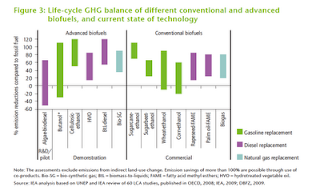
By 2050, biofuels could provide 27% of total transport fuel, supplementing diesel, kerosene and jet fuel while avoiding emissions of around 2.1 gigatonnes (Gt) of CO2 emissions per year - but only if produced sustainably, according to a new International Energy Agency (IEA) roadmap published today.
But biofuels aren't the only fuel - electric vehicles are taking to the road too, and yesterday saw the publication of a new UK Low Carbon Automotive Directory to promote UK expertise in the area for export.
What we do about transport to make it sustainable is the thorniest question facing us as we try to steer our high-energy way of life towards a more climate-friendly future.
The kind of answer arrived at affects the degree to which lifestyles, accustomed or aspiring to the freedom of movement that cars, planes, buses and trains currently offer, can continue into the future.
The IEA technology roadmap, Biofuels for Transport is positive, and provides an excellent overview of many of the fuelstocks and conversion technologies, from those in full commercial production now, to those which are just in R&D.
It also examines their carbon balance and overall sustainability, which is crucial to minimising the impact of travel.
However, it does not cover everything - it is relatively quiet on aviation fuel and in particular on jatropha. This is a plant which grows on land otherwise unusable for farming, makes biodiesel, and was recently tested by Japan Airlines, Air New Zealand, Continental, Brazil's TAM Airlines and Mexican carrier Interjet with Airbus.

A peer-reviewed Yale University study says it could reduce greenhouse gas emissions from flying by up to 60%.
140,000 formerly impoverished farmers in India are now earning a living cultivating the crop without compromising food supply or food pricing - which makes it highly sustainable. India aims to meet 20% of its diesel demand with fuel derived from plants rather than fossils by 2017.
The IEA report is also weak on the multiple benefits of algae-farming. Algae produces biodiesel while absorbing carbon dioxide from the atmosphere and processing sewage, and proposals have been made to grow it alongside industrial plants which emit the greenhouse gas. The process also produces a fertiliser and clean water.
A recent report in the New Scientist on the subject does highlight physical limits to how much we could make, but of course the fuel-source is only one amongst many.
Can we produce enough sustainable biofuels?

The IEA study says most conventional biofuel technologies need to improve conversion efficiency, cost and overall sustainability, and that current advanced, second-generation biofuels need to be commercially deployed.
We must be fully confident that the life-cycle impacts of these products do not compromise food security and biodiversity, and yield positive social impacts. This includes sustainable land-use management and certification schemes, as well as support measures that promote 斗ow-riskfeedstocks and efficient processing technologies.
The report calculates the land area requirements for biofuel feedstock, at around 100 million hectares (Mha) in 2050 - a considerable challenge given competition for land and feedstocks from rapidly-growing demand for food and fibre.
But it concludes this should be possible, and provide the required 145 EJ of total biomass for biofuels, heat and electricity from crop residues and wastes, along with sustainably grown energy crops.
Will it be expensive?
The IEA roadmap says that scale and efficiency improvements will reduce costs to make most biofuels competitive with fossil fuels by 2030.
The investment costs seem high - production costs from 2010 to 2050 in this roadmap are $11 trillion to $13 trillion, but the marginal savings or additional costs compared to use of gasoline/diesel are in the range of only +/-1% of total costs for all transport fuels - and this is without factoring in the externalities of environmental damage avoided from not using fossil fuels.
UK leadership
The UK is a pioneer in many aspects of low carbon vehicles, well-placed to profit from the global shift to sustainable transport. The updated UK Low Carbon Automotive Directory has been produced to help boost the export market for this emerging sector.
It lists suppliers, partners and new solutions from the UK's businesses and research institutions in areas such as manufacturing, components, transmissions & drive trains, energy recovery & storage (batteries and flywheels), electrical recharging infrastructure, fuels & infrastructure and hydrogen and fuel cells.
The sector is supported by the BIS Automotive Unit with the DfT's Office for Low Emission Vehicles (OLEV) and LowCVP.
Crucial to fostering UK success is Cenex - the UK's first Centre of Excellence for low carbon and fuel cell technologies.
Cenex has just launched its website allowing registration for the key trade show for the sector, LCV2011, the 4th annual Low Carbon Vehicle event which will take place on 7th and Thursday 8th September 2011.
Navigating the route to a low-carbon travel is tricky, but the encouraging message is that it is potentially achievable.
No comments:
Post a Comment